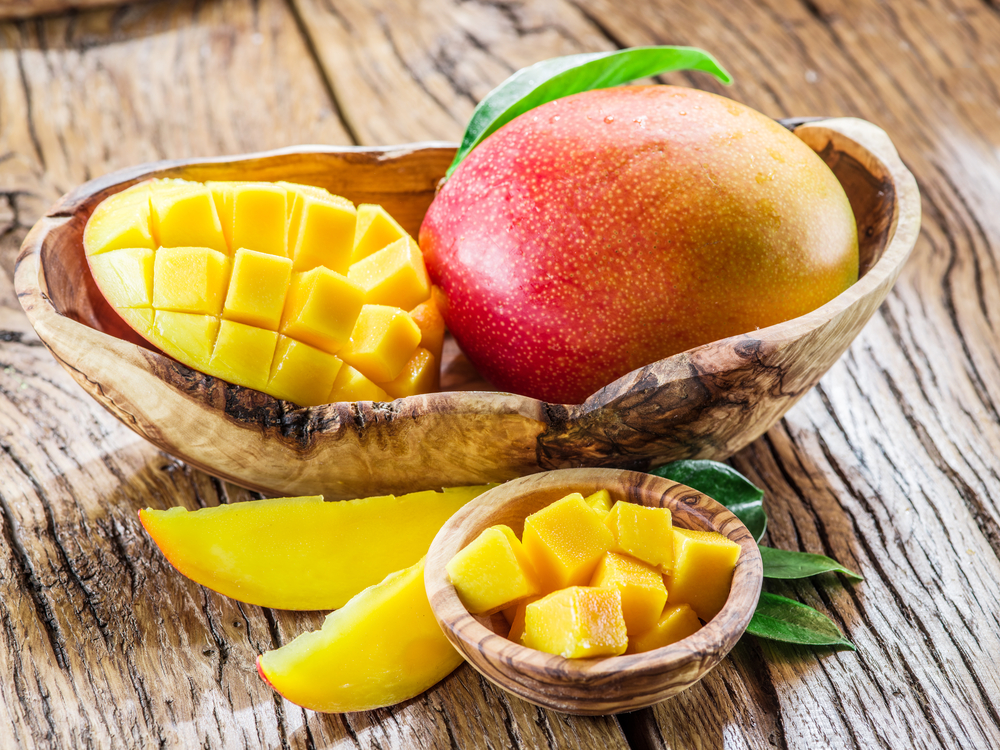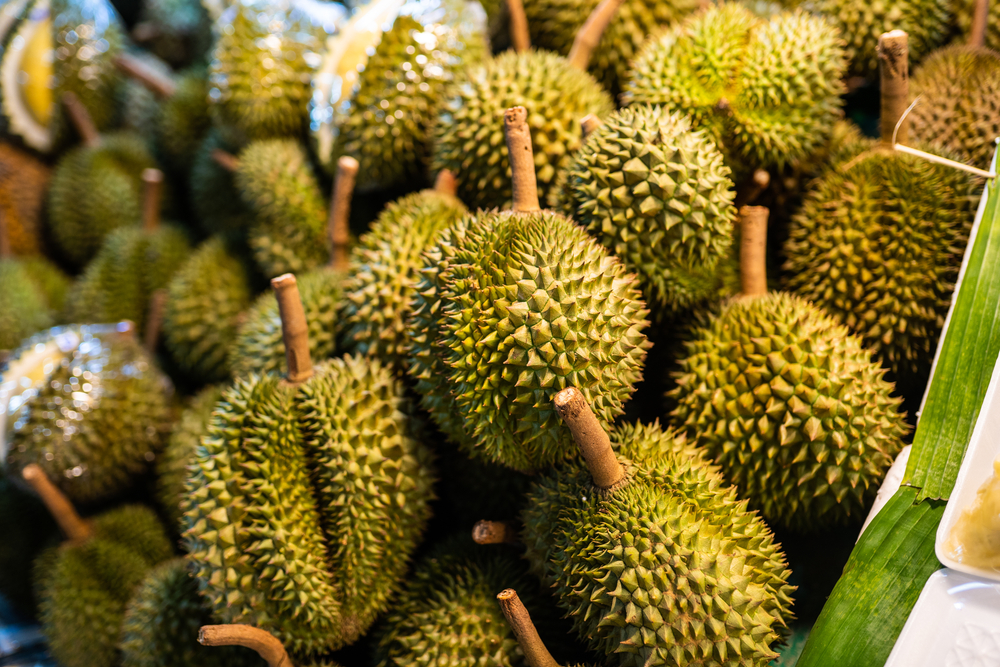I recently tried papaya for the first time and was pleasantly surprised by its unique taste. The fruit has a sweet and slightly musky flavor that is similar to a combination of cantaloupe and mango.
The texture is soft and buttery, with small black seeds in the center that are edible but have a slightly bitter taste.
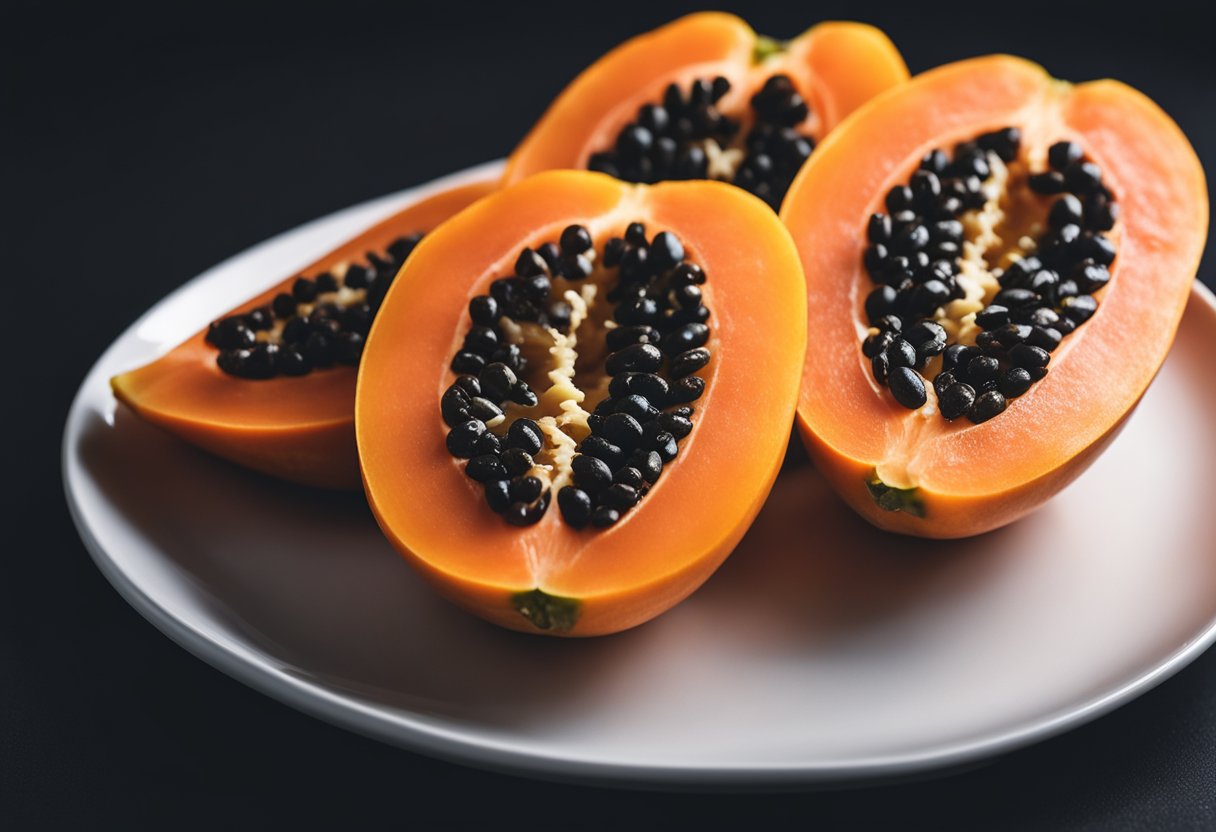
The taste of papaya can vary depending on its ripeness. When the fruit is unripe, it has a harder flesh with little to no flavor and a less appealing smell.
However, when the papaya is ripe, it has a juicy, flavorful flesh that is well worth trying.
Key Takeaways
- Papaya has a sweet and slightly musky flavor that is similar to a combination of cantaloupe and mango.
- The texture of papaya is soft and buttery, with small black seeds in the center that are edible but have a slightly bitter taste.
- The taste of papaya can vary depending on its ripeness, with ripe papaya having a juicy, flavorful flesh that is well worth trying.
Understanding the Taste of Papaya
As someone who has tasted papaya multiple times, I can confidently say that it has a unique and delicious taste.
The flavor of papaya is sweet, musky, and tropical, making it a popular fruit in many parts of the world. However, the taste of papaya is highly dependent on its ripeness.
When papaya is ripe, it has a mild sweetness that is not overpowering. The sweetness is usually balanced by a slight tanginess, which gives it a refreshing taste.
The texture of ripe papaya is soft and buttery, which makes it easy to eat. The flesh of the fruit is usually a bright orange color, which adds to its visual appeal.
On the other hand, unripe papaya has a completely different taste. It is usually quite bland and has a firm texture.
Some people describe the taste of unripe papaya as being similar to that of a cucumber. Overripe papaya, on the other hand, can have a strong musky flavor that is not very pleasant.
Papaya is a versatile fruit that can be enjoyed in many different ways. It can be eaten on its own as a snack, added to salads, or used in smoothies.
In some parts of the world, papaya is also used in savory dishes, such as curries.
In conclusion, papaya has a unique and delicious taste that is sweet, musky, and tropical. Its taste is highly dependent on its ripeness, with ripe papaya having a mild sweetness and a soft, buttery texture.
Papaya is a versatile fruit that can be enjoyed in many different ways and is a great addition to any diet.
Texture and Consistency
When it comes to the texture and consistency of papaya, it can vary depending on the ripeness of the fruit. Generally, papayas are soft and have a creamy texture, which makes them easy to eat.
The flesh of the fruit is typically smooth and buttery, making it a popular choice for smoothies and desserts.
If you are looking for a firmer texture, you can try selecting a papaya that is slightly underripe. The flesh of an underripe papaya will be firmer and less creamy, similar to the texture of a melon.
However, an underripe papaya may not be as sweet as a fully ripe one.
On the other hand, an overripe papaya may have a mushy texture and an unpleasant smell. It is important to select a papaya that is just right, with a soft and creamy texture that is not too mushy or too firm.
Overall, the texture and consistency of papaya is one of its defining characteristics. Its soft and creamy texture makes it a delicious and versatile fruit that can be used in a variety of dishes.
Whether you enjoy it on its own or in a smoothie, papaya is sure to delight your taste buds with its unique flavor and texture.
Color and Appearance
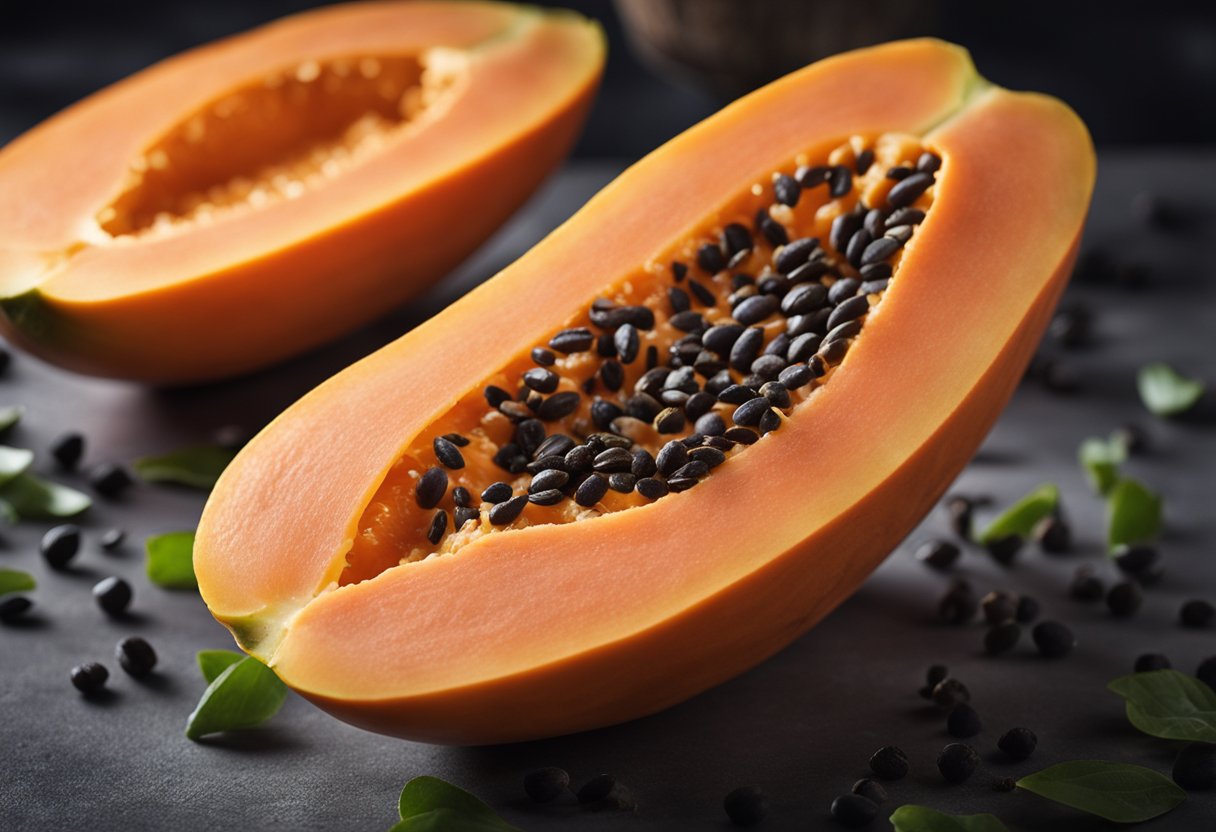
When it comes to papayas, color and appearance can tell you a lot about the fruit’s ripeness and taste. Papayas come in different sizes, shapes, and colors, but the most common ones are oval or pear-shaped with a yellow-green skin that turns yellow-orange as it ripens.
The flesh of a papaya is typically a bright orange color with small black seeds in the center.
The skin of a papaya can range from green to yellow to orange, depending on the fruit’s ripeness. A ripe papaya will have a bright yellow-orange skin with no green spots, while an unripe papaya will have a green skin with some yellow spots.
The skin of a papaya is thin and delicate, and it bruises easily, so it’s important to handle it with care.
The flesh of a papaya is soft, juicy, and sweet, with a texture that is similar to a ripe mango or cantaloupe. The flavor of a papaya can be described as sweet and musky, with a slight bitterness or sourness that is more pronounced in unripe fruits.
The taste of a papaya can vary depending on the fruit’s ripeness, with riper fruits having a sweeter taste.
In terms of size, papayas can range from small to large, with the most common size being around 7-10 inches in length and 1-2 pounds in weight.
The shape of a papaya can also vary, with some fruits being more oval-shaped and others being more pear-shaped.
Overall, the color and appearance of a papaya can give you a good idea of the fruit’s ripeness and taste.
A ripe papaya will have a bright yellow-orange skin, a soft and juicy flesh, and a sweet and musky flavor, while an unripe papaya will have a green skin, a firmer flesh, and a more bitter or sour taste.
Ripeness and Storage
When it comes to papayas, ripeness is key to enjoying their unique flavor. A ripe papaya should be soft to the touch and have a mostly yellow skin.
If the skin is still green, the papaya is unripe and will taste bitter. On the other hand, if the skin is mostly brown or black, the papaya is overripe and will have a mushy texture and overly sweet taste.
If you purchase an unripe papaya, you can speed up the ripening process by placing it in a paper bag with an apple or banana.
These fruits release ethylene gas, which helps to ripen the papaya faster. Once the papaya is ripe, you can store it in the refrigerator for a few days to prolong its freshness.
When storing a ripe papaya, it’s important to keep it separate from other fruits and vegetables, as it can release a gas that can cause them to spoil faster.
You can also cut a ripe papaya into slices and freeze them for later use in smoothies or other recipes.
Overall, it’s important to pay attention to the ripeness of your papaya to ensure the best possible flavor.
With proper storage techniques, you can enjoy the unique taste of papaya for days after purchase.
Papaya Varieties and Origins
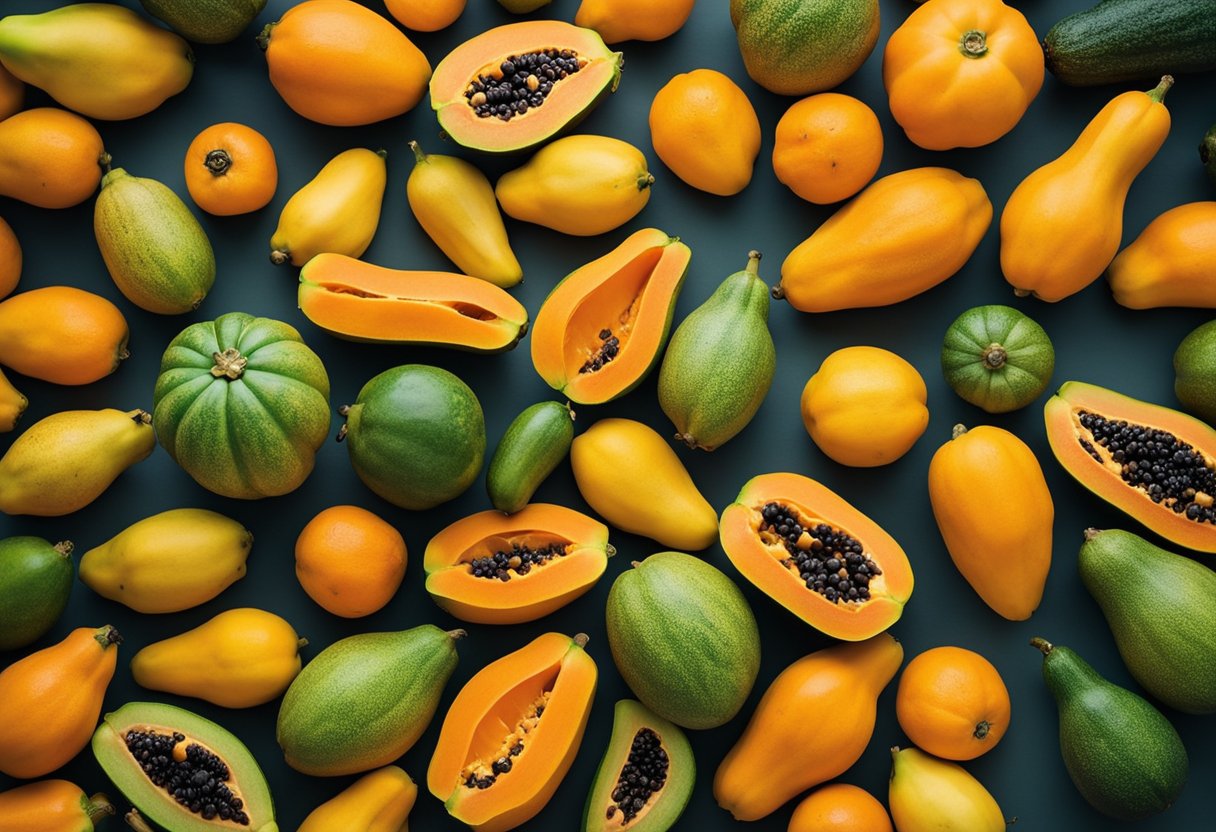
Papaya is a round tropical fruit that is native to Mexico, Central America, and South America. It is also grown in India and Africa. There are several varieties of papaya, each with its own unique taste, texture, and appearance.
The most common variety of papaya is the Solo papaya, which has a yellow-orange skin and orange flesh. It is sweet and has a musky flavor.
Another popular variety is the Maradol papaya, which has a green skin when unripe and turns yellow when ripe. The flesh is bright orange and has a sweet, juicy taste.
Hawaiian papayas are also popular, with the Sunrise papaya having red-orange flesh that tastes similar to berries, peaches, and melons.
The Sunset papaya is a dwarf variety that originated in the University of Hawaii and has a sweet, juicy flavor.
Papayas have been cultivated for thousands of years and were highly prized by the Mayans and Aztecs.
They were introduced to Europe by Spanish explorers in the 16th century and have since become popular all over the world.
Today, papayas are grown in many tropical and subtropical regions and are enjoyed for their sweet taste, juicy texture, and numerous health benefits.
They are rich in vitamins A and C, potassium, and fiber, making them a nutritious addition to any diet.
In summary, papaya is a delicious and nutritious fruit with several varieties that have unique tastes and appearances. Its origins can be traced back to Mexico and Central America, and it has since been cultivated in many other regions.
Preparing and Eating Papaya
Papaya is a tropical fruit with a unique taste and texture. It is a great addition to salads, smoothies, and other dishes. Here are some tips for preparing and eating papaya.
Choosing a Ripe Papaya
When selecting a papaya, look for one that is mostly yellow with a few green patches. If the papaya is mostly green, it is not ripe yet. If it is mostly orange, it is overripe and may be mushy. The skin should be smooth and free of blemishes or soft spots.
Preparing a Papaya
To prepare a papaya, wash it thoroughly and cut it in half lengthwise. Scoop out the seeds with a spoon and discard them. The seeds are edible but have a bitter taste. You can also save the seeds to plant your own papaya tree.
Serving Papaya
Papaya can be served raw or cooked. To serve it raw, cut it into cubes or slices and add it to a fruit salad. Papaya pairs well with other tropical fruits like mango and cantaloupe.
It can also be blended into a smoothie with yogurt and honey for a refreshing breakfast drink.
For a savory dish, papaya can be used to make salsa or added to a green salad. It also pairs well with seafood and can be grilled or baked with fish or shrimp.
For a sweet treat, top papaya with whipped cream or coconut cream. It can also be used to make a papaya sorbet or ice cream.
Conclusion
Papaya is a versatile fruit that can be enjoyed in many ways. Whether you eat it raw or cooked, papaya is a delicious and healthy addition to your diet.
Papaya in Different Cuisines
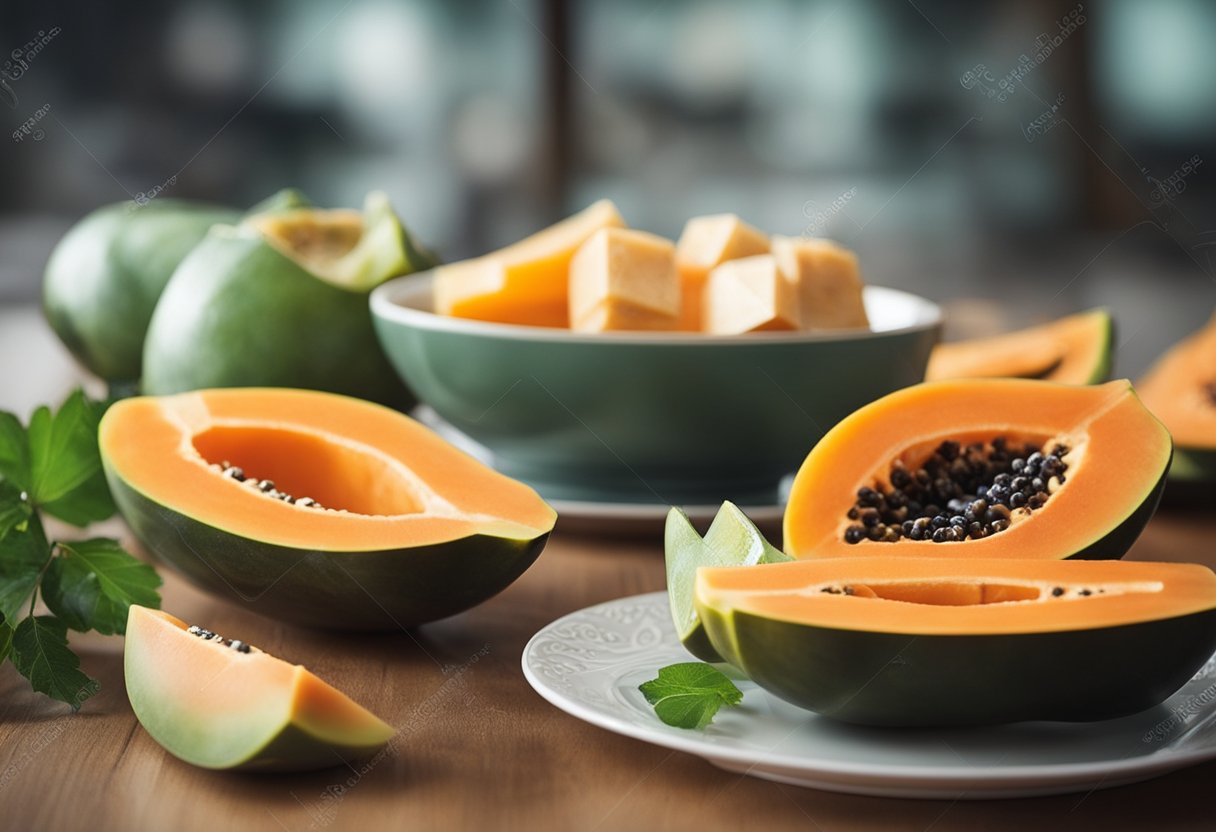
I have tasted papaya in various cuisines, and it’s fascinating how it can be used in different ways to create unique flavors. Here are some examples of how papaya is used in different cuisines:
Asian Cuisine
Papaya is a common ingredient in Southeast Asian cuisine, especially in Thai cuisine. Green papaya salad, also known as “som tam,” is a popular dish made with shredded unripe papaya, garlic, chili, lime juice, fish sauce, and peanuts.
The dish has a tangy, spicy, and slightly sweet flavor that is refreshing and perfect for hot weather. In addition to salads, papaya is also used in curries, soups, and stir-fries in Southeast Asian cuisine.
Salsas
Papaya is an excellent addition to salsas, adding a sweet and tropical flavor to the mix. It pairs well with other fruits like mango, pineapple, and citrus fruits, as well as with savory ingredients like onion, garlic, and cilantro.
Papaya salsa is a delicious topping for grilled fish or chicken, and it can also be served with tortilla chips as a snack.
Cooked
Papaya can also be cooked, and it’s a popular ingredient in Caribbean and Latin American cuisine. In the Dominican Republic, papaya is used in a stew called “sancocho,” which is made with various meats, vegetables, and spices.
In Jamaica, papaya is used in a dish called “run down,” which is a seafood stew made with coconut milk, papaya, and spices.
In addition to stews, papaya is also used in soups, rice dishes, and even desserts in Caribbean and Latin American cuisine.
Overall, papaya is a versatile fruit that can be used in many different ways to create unique and delicious flavors.
Whether it’s in a salad, salsa, or stew, papaya adds a sweet and tropical taste that is hard to resist.
Health Benefits and Nutritional Value
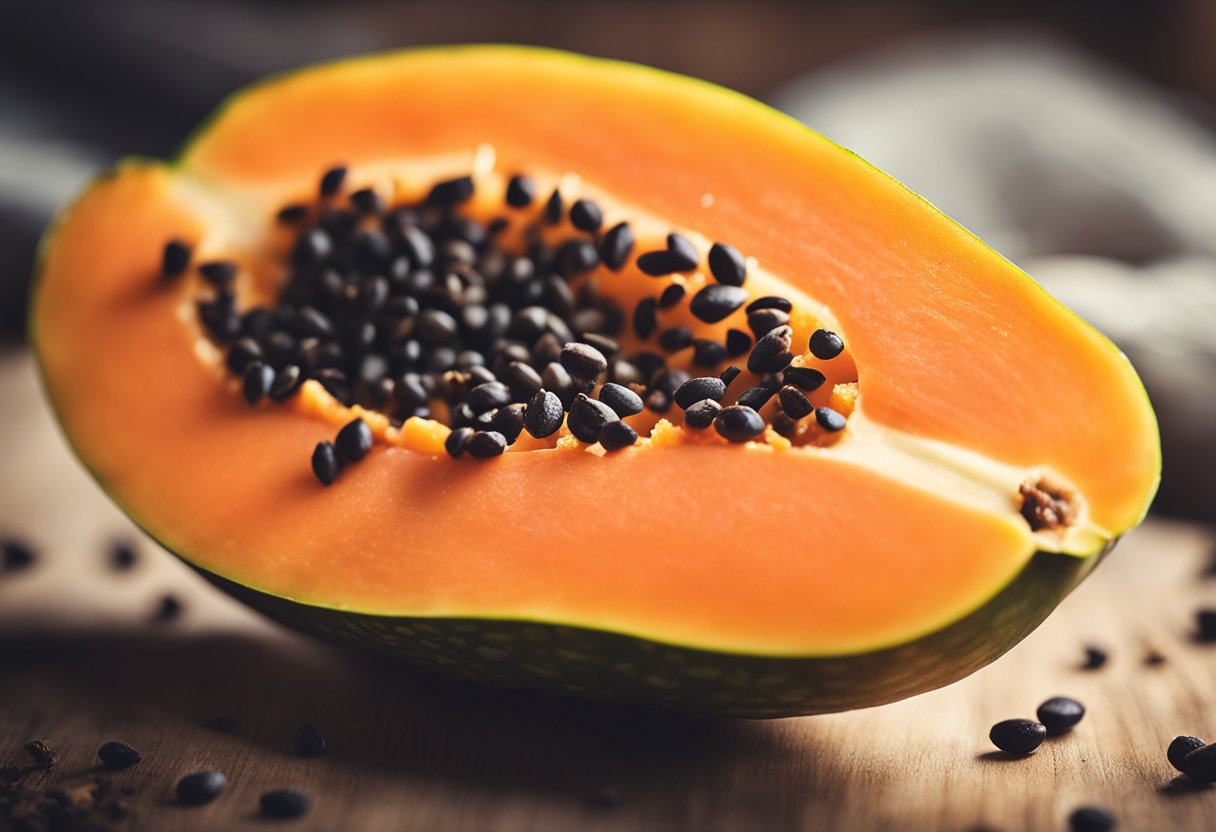
As a fruit, papaya is known for its rich nutritional value and health benefits. It is a good source of antioxidants, vitamin C, and fiber, making it an excellent addition to any diet.
One of the most significant health benefits of papaya is its high antioxidant content.
Antioxidants help protect the body against free radicals, which can cause damage to cells and lead to chronic diseases like cancer and heart disease. Papaya contains several antioxidants, including beta-carotene, lycopene, and zeaxanthin.
Papaya is also rich in papain, an enzyme that aids in digestion. This enzyme breaks down proteins in the body, making it easier for the body to absorb nutrients. Regular consumption of papaya can help improve digestion and prevent constipation.
In addition to its enzyme content, papaya is also high in fiber. Fiber is essential for maintaining a healthy digestive system and can help prevent constipation.
A single serving of papaya contains approximately 2.5 grams of fiber, making it a great addition to any diet.
Finally, papaya is also an excellent source of vitamin C. This vitamin is essential for a healthy immune system and can help protect the body against infection and disease.
A single serving of papaya contains over 100% of the recommended daily value of vitamin C, making it one of the best natural sources of this essential nutrient.
Overall, papaya is a delicious and nutritious fruit that can provide a wide range of health benefits. Whether you’re looking to improve your digestion, boost your immune system, or simply enjoy a tasty snack, papaya is an excellent choice.
Identifying Quality Papayas
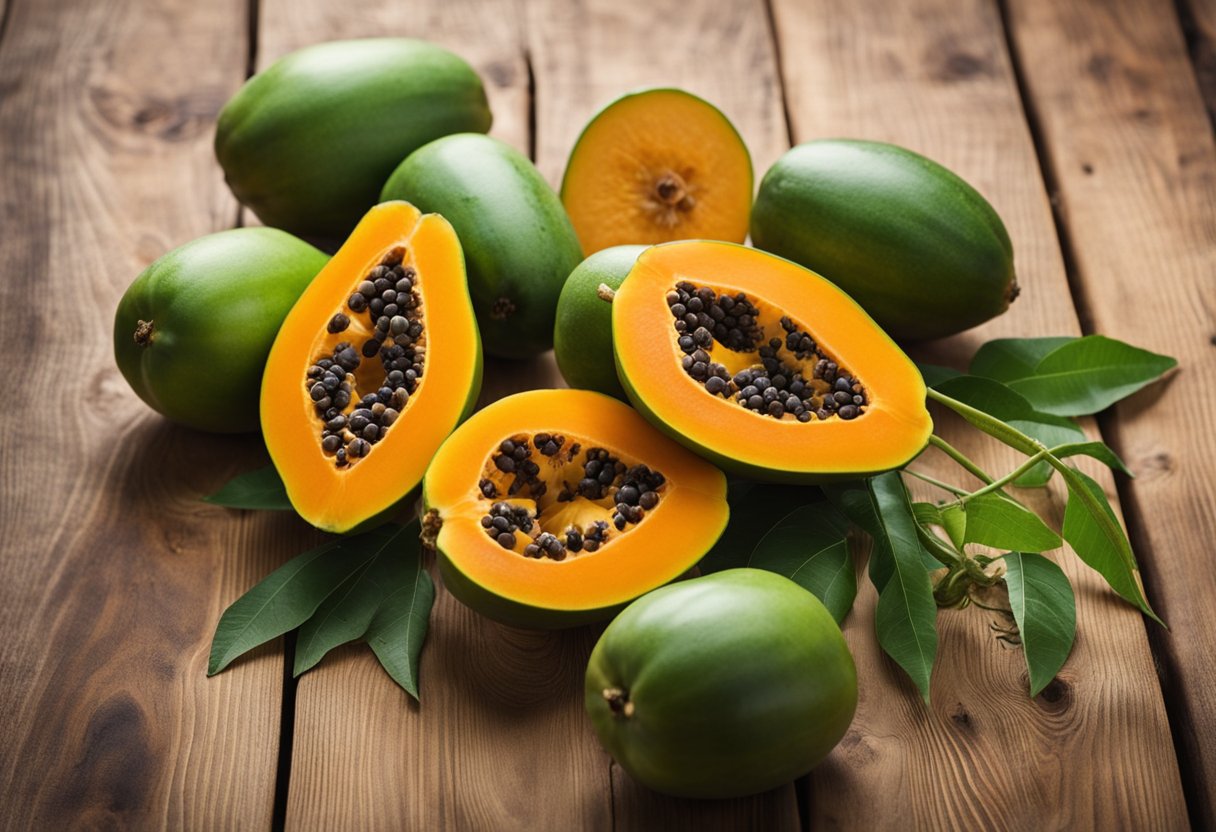
As a fruit lover, I always want to make sure that I get the best quality papayas. Here are some tips that I use to identify quality papayas:
Look at the Stem
The stem of a papaya is a great indicator of its quality. A healthy papaya should have a green stem. If the stem is brown or black, it means that the papaya is overripe. If the stem is missing, it means that the papaya is not fresh.
Check for Holes and Mold
Inspect the papaya for any holes or mold. Holes can be a sign of insect damage, while mold can be a sign of poor storage. If you see any holes or mold, it is best to avoid that papaya.
Avoid Papayas with Blemishes
Blemishes on the skin of a papaya can be a sign of poor quality. Look for papayas with smooth, unblemished skin. If the papaya has any bruises, dents, or scratches, it may not be as fresh as you would like.
Check for Mushy Spots
Press gently on the papaya to check for any mushy spots. If the papaya feels soft or mushy in any areas, it may be overripe or spoiled.
Pick a Heavy Papaya
A heavy papaya is a good indicator of its ripeness. A ripe papaya should feel heavy for its size. If the papaya feels light, it may not be ripe yet.
By following these tips, you can easily identify quality papayas and enjoy their delicious taste.
Other Uses of Papaya
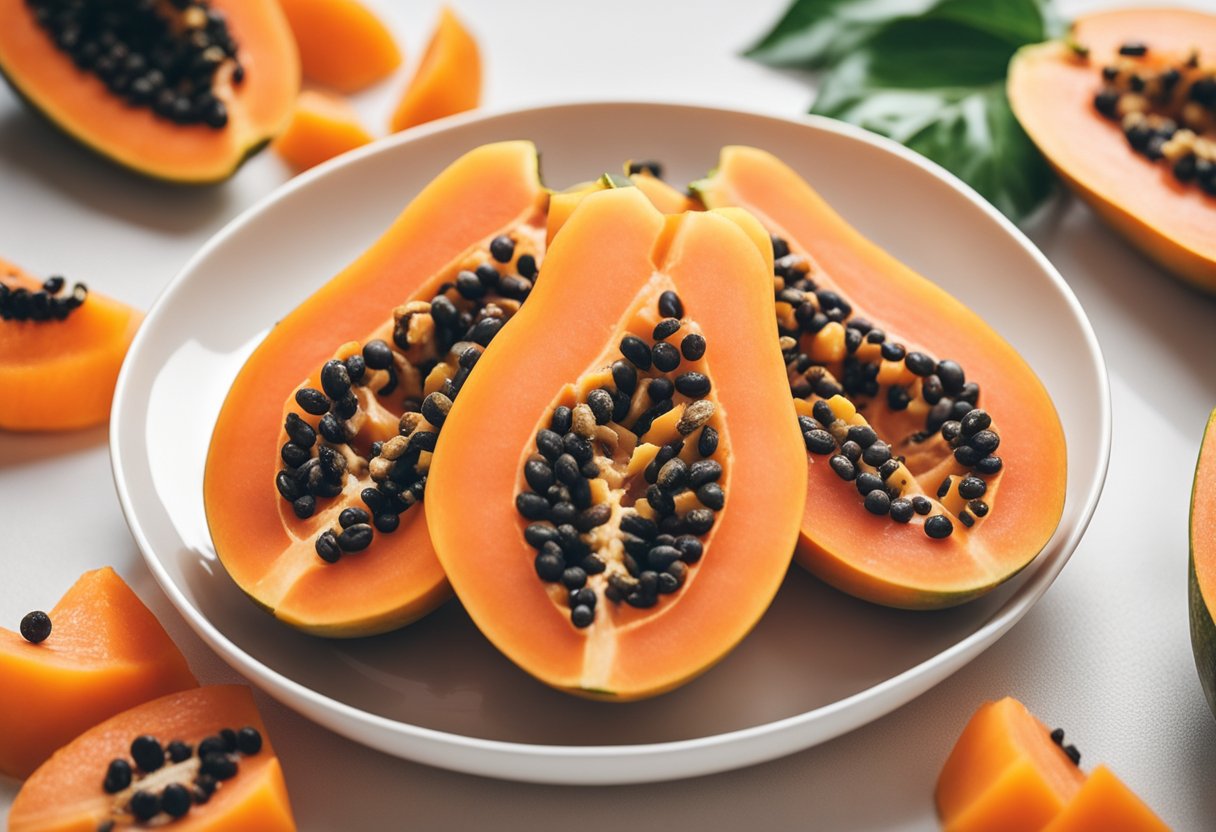
Apart from being an edible fruit, papaya has several other uses that are worth exploring. In this section, I will discuss some of the various uses of papaya, which include medicinal, cosmetic, and culinary uses.
Medicinal Uses
Papaya has been used for centuries as a natural remedy for various ailments. The fruit contains enzymes that aid in digestion and can help relieve constipation.
Papaya also contains high levels of vitamin C, which can boost the immune system and help fight off infections.
Papaya leaves have also been used to treat infections and reduce inflammation. In the Philippines, papaya leaves are boiled and used to make a tea that is believed to have medicinal properties.
Some studies have even suggested that papaya leaves may have anti-cancer properties, although more research is needed to confirm this.
Papaya seeds are also believed to have medicinal properties. They have been used to treat parasites and are sometimes added to smoothies or other drinks as a natural remedy for digestive issues.
Cosmetic Uses
Papaya is also used in various cosmetic products due to its skin-nourishing properties. The fruit contains enzymes that can help exfoliate the skin, leaving it soft and smooth.
Papaya is also rich in antioxidants, which can help protect the skin from damage caused by free radicals.
Some cosmetic products that contain papaya include face masks, body scrubs, and lotions. Papaya is also sometimes used in hair care products to help nourish and strengthen the hair.
Culinary Uses
In addition to being an edible fruit, papaya can also be used in various culinary applications. The fruit can be frozen and blended into smoothies or used to make sorbet or ice cream. Papaya can also be used in salads or as a topping for yogurt or oatmeal.
Papaya seeds can also be used in cooking. They have a slightly spicy flavor and can be used as a substitute for black pepper. Papaya seeds can also be ground up and used as a spice in various dishes.
Overall, papaya is a versatile fruit that has many different uses. Whether you are looking for a natural remedy for an ailment, a skin-nourishing cosmetic product, or a new ingredient to add to your culinary repertoire, papaya is definitely worth exploring.
Frequently Asked Questions
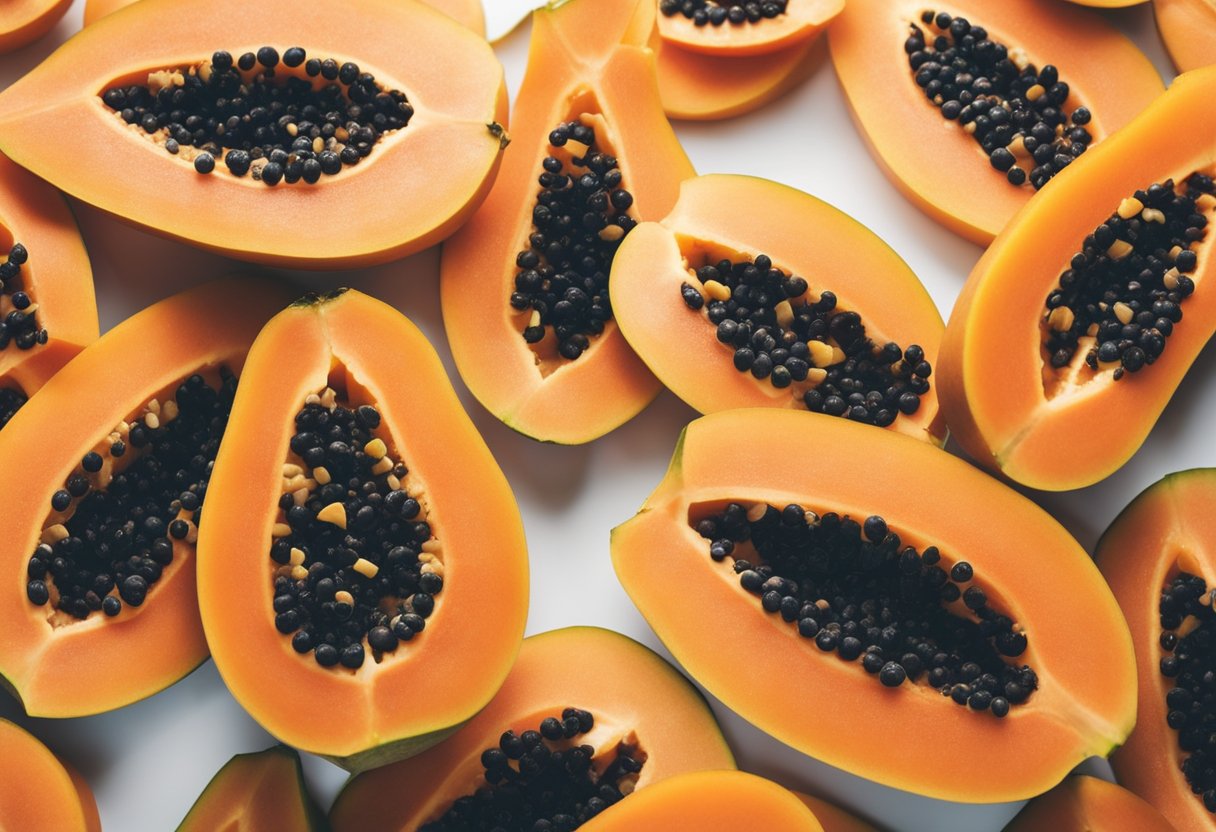
What are some tips for making papaya taste good?
To make papaya taste good, you should choose a ripe papaya, which is soft to the touch and has a sweet aroma. You can also add a squeeze of lime or lemon juice to enhance the flavor.
Additionally, try adding papaya to smoothies or salads to enjoy its tropical taste.
What does ripe papaya smell like?
Ripe papaya has a sweet, fruity aroma. If it smells musky or sour, it may be overripe and not taste as good.
How do you eat papaya and make it taste good?
To eat papaya, cut it in half lengthwise and scoop out the seeds with a spoon. You can eat papaya plain or add it to fruit salads, smoothies, or salsa. To enhance the flavor, try adding a squeeze of lime or lemon juice.
Are papayas good for you?
Yes, papayas are good for you. They are high in vitamin C, fiber, and antioxidants. They also contain enzymes that aid in digestion and may have anti-inflammatory effects.
How long does it take for a papaya to ripen?
It takes about 3-5 days for a papaya to ripen at room temperature. You can speed up the ripening process by placing the papaya in a paper bag with an apple or banana.
What does papaya taste similar to?
Papaya has a unique flavor that is difficult to compare to other fruits. Some people describe it as a mix between a mango and a cantaloupe, while others say it has a slightly floral taste.



